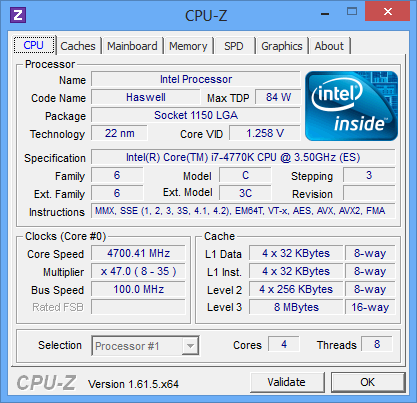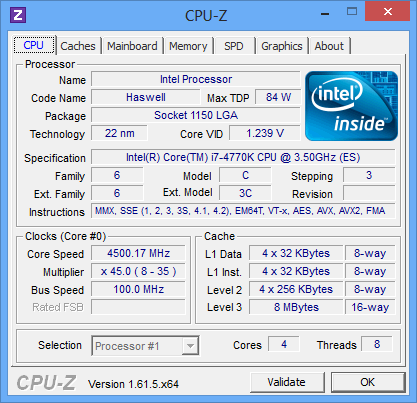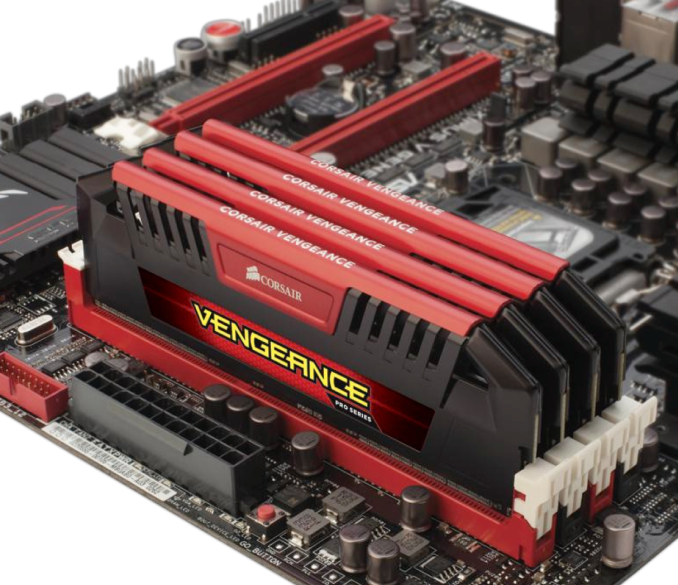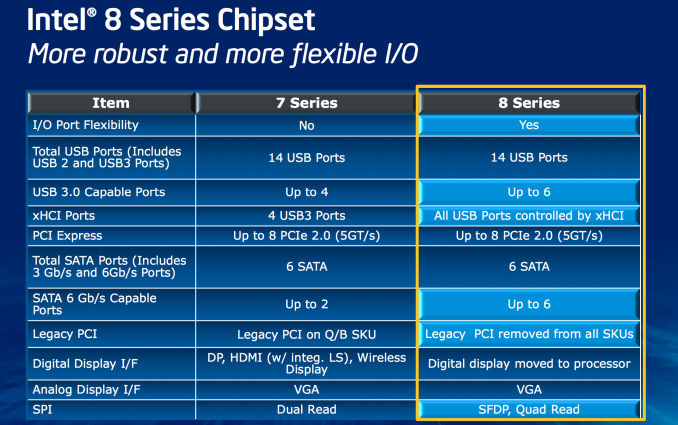The Haswell Review: Intel Core i7-4770K & i5-4670K Tested
by Anand Lal Shimpi on June 1, 2013 10:00 AM ESTMemory
Haswell got an updated memory controller that’s supposed to do a great job of running at very high frequencies. Corsair was kind enough to send over some of its Vengeance Pro memory with factory DDR3-2400 XMP profiles. I have to say, the experience was quite possibly the simplest memory overclocking I’ve ever encountered. Ivy Bridge was pretty decent at higher speeds, but Haswell is a different beast entirely.
Although I used DDR3-2400 for most of my testing, Corsair’s Vengeance Pro line is available in frequencies rated all the way up to 2933MHz.
Platform
Haswell features a new socket (LGA-1150). Fundamental changes to power delivery made it impossible to maintain backwards compatibility with existing LGA-1155 sockets. Alongside the new socket comes Intel’s new 8-series chipsets.
At a high level the 8-series chipsets bring support for up to six SATA 6Gbps and USB 3.0. It’s taken Intel far too long to move beyond two 6Gbps SATA ports, so this is a welcome change. With 8-series Intel also finally got rid of legacy PCI support.
Overclocking
Despite most of the voltage regulation being moved on-package, motherboards still expose all of the same voltage controls that you’re used to from previous platforms. Haswell’s FIVR does increase the thermal footprint of the chip itself, which is why TDPs went up from 77W to 84W at the high-end for LGA-1150 SKUs. Combine higher temperatures under the heatspreader with a more mobile focused chip design, and overclocking is going to depend on yield and luck of the draw more than it has in the past.
Haswell doesn’t change the overclocking limits put in place with Sandy Bridge. All CPUs are frequency locked, however K-series parts ship fully unlocked. A new addition is the ability to adjust BCLK to one of three pre-defined straps (100/125/167MHz). The BCLK adjustment gives you a little more flexibility when overclocking, but you still need a K-SKU to take advantage of the options.


In terms of overclocking success on standard air cooling you should expect anywhere from 4.3GHz - 4.7GHz at somewhere in the 1.2 - 1.35V range. At the higher end of that spectrum you need to be sure to invest in a good cooler as you’re more likely to bump into thermal limits if you’re running on stable settings.

















210 Comments
View All Comments
Amaranthus - Monday, June 3, 2013 - link
One of the main (and already implemented) uses of TSX is hardware lock elision. I'd guess the hypothesis is that physics code takes locks defensively but rarely actually have contention because they're working on different parts of the world. In this scenario more fine grained locks on sections of the world would let you scale better but that is a lot of work and HLE gives you the same benefit for free.Jaybus - Monday, June 3, 2013 - link
No. HLE (XACQUIRE and XRELEASE) do nothing by themselves. They reuse REPNE/REPE prefixes and on CPUs that do not support TSX are ignored on instructions that would be valid for XACQUIRE/XRELEASE if TSX were available. It is a backward compatibility method. Since all of those instructions may have a LOCK prefix, without TSX capability, a normal lock is used, NOT the optimistic locking provided by TSX that allows other threads to see the lock as already free.Without TSX the code is still (software) lock-free, but there is no possibility of multiple threads accessing the same memory simultaneously (as there is with TSX), so one or more threads will see a pipeline stall due to the LOCK prefix.
bji - Monday, June 3, 2013 - link
I can't imagine that lock elision is that beneficial to very many applications. Lock contention is almost never a significant performance bottleneck; yeah there are poorly designed applications where lock contention can have a more significant effect, but proper multithreaded coding has the contended sections of code reduced to the smallest number of instructions possible, at which point the effects of lock contention are minimized.In order to take advantage of transactional memory and get the full benefits of TSX you have to write such radically different algorithms that I doubt that it's worth it except in the most unusual and specific cases. OK so you can use TSX instructions to make a hashtable or other container class suffer slightly less from lock contention, but that is oh so very rarely a significant aspect to the performance of any program.
klmccaughey - Monday, June 3, 2013 - link
As a programmer, I disagree. This is a very useful feature set that, if it was more widely adopted, would prove very useful for many workaday tasks that the CPU performs.bji - Monday, June 3, 2013 - link
As a programmer, I am pretty sure that the benefits of TSX are limited to a very unusual and uncommon set of problems the performance increase of which will mean very very little to 99.99% of users 99.99% of the time. Also fully transactional memory algorithms require significant rework from their non-transactional counterparts meaning that taking full advantage of TSX takes developer effort which will not be worth it except in very rare circumstances.The HLE instructions may have some very minor benefit because they can be used with algorithms that don't need to be reworked at all (you just get a little bit more parallelism for free), but even then you're going to be avoiding some lock contention; even if you completely eliminated lock contention from most algorithms they would only be fractionally faster in real world usage. Lock contention just isn't that big of a deal in normal circumstances.
klmccaughey - Monday, June 3, 2013 - link
Exactly. It would be the ubiquity of these features that would cause them to be useful - splitting them into segments defeats the adoption and use of said features. Intel are pushing segmentation too hard (too greedily?)bill5 - Saturday, June 1, 2013 - link
kind if a weird, scattered review.loved the q6600 though, since i still have one. and the 8350, since i have my eye on it.
be interesting if this pushed 8350 prices down enough to be more attractive (it's currently only 180 on newegg). if not i'll probably go with i5 4670 (even though i'm getting tired of these faux msrp's, bet money that chip will be 229 on newegg forget 213)
ps, my bill4 account was apparently banned (it kept saying i was posting spam wouldn't allow me to post) i post controversial things that probably get downvoted, but they arent spam. please stop doing that.
bill5 - Saturday, June 1, 2013 - link
this really shows where the 8350 fails, single thread.it looks like clock for clock it's ipc may be similar to my q6600. it only gains in single thread due to the gaudy 4.0 clock speed.
otoh go to multithread and it holds it's own against the other ~200 intel chips.
Nexus-7 - Saturday, June 1, 2013 - link
In for one 4770k --I'm coming from an i5-750 running at 4GHz. I'm thinking this will be a sufficiently large leap forward although I'm tempted to wait for Ivy Bridge-E's 6c12t monsters.
chizow - Saturday, June 1, 2013 - link
Similar boat, but I told myself I wouldn't wait for Intel's E platform anymore. X58 may be the last great E platform, mainly because it actually preceded the rest of the mainstream performance parts. Intel seems to sit on these E platforms for so long now that they almost become irrelevant by the time they launch.